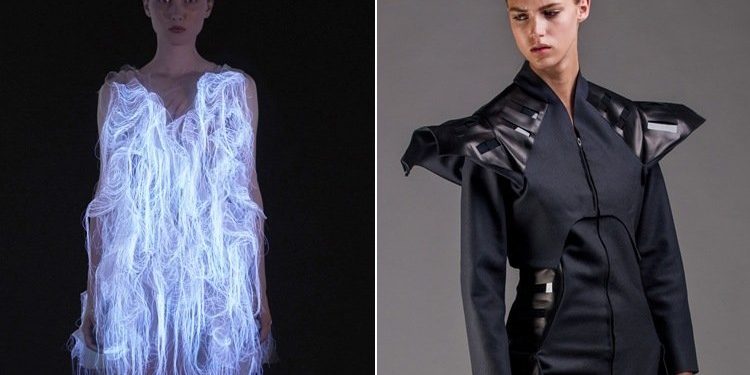Technology Apparel: The Future of Clothing
Technology apparel, the intersection of fashion and technology, is revolutionizing the way we dress and interact with the world around us. From smartwatches and fitness trackers to heated jackets and […]

Technology apparel, the intersection of fashion and technology, is revolutionizing the way we dress and interact with the world around us. From smartwatches and fitness trackers to heated jackets and self-cleaning fabrics, technology is seamlessly integrating into our clothing, enhancing functionality, comfort, and style.
This fusion of technology and apparel is not merely a trend; it’s a transformation that’s shaping the future of fashion, offering unprecedented opportunities for innovation and personalization.
Types of Technology in Apparel
Apparel technology is revolutionizing the way we dress, enhancing comfort, performance, and functionality. From wearable sensors that monitor our health to smart fabrics that adapt to our environment, the possibilities are endless.
Wearable Sensors
Wearable sensors are small, electronic devices integrated into clothing that collect data about the wearer’s body and environment. These sensors can track a wide range of metrics, including heart rate, body temperature, activity levels, and even sleep patterns.
The data collected by wearable sensors can be used for various applications, such as:
- Fitness and Wellness: Wearable sensors are widely used in fitness trackers and smartwatches to monitor exercise performance, calorie expenditure, and sleep quality. They provide valuable insights for individuals seeking to improve their health and well-being.
- Healthcare Monitoring: Wearable sensors are increasingly being used in healthcare settings to monitor patients with chronic conditions, such as heart disease, diabetes, and respiratory illnesses. They can provide real-time data to healthcare professionals, enabling early detection and intervention.
- Safety and Security: Wearable sensors can be used to enhance safety in various situations. For example, they can detect falls in elderly individuals or alert emergency services in case of accidents.
Smart Fabrics
Smart fabrics are textiles that have been engineered with advanced functionalities, such as conductivity, breathability, and responsiveness to external stimuli. They can change color, adjust temperature, or even provide electrical stimulation.
Here are some examples of smart fabrics and their applications:
- Thermo-regulating Fabrics: These fabrics can adapt to changes in temperature, keeping the wearer cool in hot weather and warm in cold weather. They are commonly used in athletic wear and outdoor clothing.
- Conductive Fabrics: These fabrics allow for the integration of electronic circuits and sensors, enabling applications such as touchscreens, heating elements, and even bio-monitoring. They are used in sportswear, medical garments, and wearable technology.
- Light-Emitting Fabrics: These fabrics incorporate light-emitting diodes (LEDs) that can be used for various purposes, such as safety signage, decorative elements, and even communication signals. They are used in safety gear, fashion accessories, and interactive displays.
Embedded Electronics
Embedded electronics refer to electronic components that are integrated directly into apparel, such as microprocessors, memory chips, and communication modules. These components can perform various functions, including data processing, wireless communication, and power management.
Here are some examples of embedded electronics in apparel:
- Smartwatches: Smartwatches are wearable devices that combine embedded electronics with a display and touch interface. They offer a wide range of functionalities, including notifications, fitness tracking, and mobile payments.
- Smart Jackets: Smart jackets can integrate embedded electronics to provide features such as heated panels, GPS tracking, and even voice control. They are used in various applications, including outdoor recreation, safety, and fashion.
- E-Textiles: E-textiles are fabrics that have been integrated with electronic circuits and sensors. They can be used to create interactive clothing, such as garments that can change color, react to touch, or even provide haptic feedback.
Technology Apparel: Key Features, Benefits, and Limitations
| Type of Technology | Key Features | Benefits | Limitations |
|---|---|---|---|
| Wearable Sensors | – Small, electronic devices integrated into clothing – Collect data about the wearer’s body and environment – Track heart rate, body temperature, activity levels, etc. |
– Enhanced fitness and wellness monitoring – Improved healthcare monitoring – Increased safety and security |
– Battery life can be limited – Data privacy concerns – May not be comfortable for all wearers |
| Smart Fabrics | – Textiles engineered with advanced functionalities – Conductivity, breathability, responsiveness to stimuli – Change color, adjust temperature, provide electrical stimulation |
– Enhanced comfort and performance – Improved functionality and adaptability – Potential for innovative applications |
– Can be expensive to produce – May not be durable or washable – Limited availability of advanced materials |
| Embedded Electronics | – Electronic components integrated directly into apparel – Microprocessors, memory chips, communication modules – Data processing, wireless communication, power management |
– Increased functionality and connectivity – Enables a wide range of applications – Potential for future advancements |
– Can be bulky and uncomfortable – May be susceptible to damage – Requires power source and charging |
Applications of Technology Apparel
Technology apparel has become increasingly prevalent in various industries, revolutionizing how we work, exercise, and live our lives. These garments integrate sensors, electronics, and software to enhance performance, monitor health, improve safety, and provide convenience. This technology is not limited to sportswear; it is finding its way into diverse applications across healthcare, fitness, fashion, and safety domains.
Healthcare
Technology apparel plays a significant role in revolutionizing healthcare by enabling continuous monitoring of vital signs, early disease detection, and personalized treatment plans.
- Wearable health monitors: Smartwatches, fitness trackers, and other wearable devices can monitor heart rate, blood pressure, sleep patterns, and other vital signs. This data can be used to identify potential health issues early and help individuals manage their health proactively.
- Remote patient monitoring: Telemedicine platforms leverage technology apparel to remotely monitor patients’ health conditions, allowing healthcare professionals to provide timely interventions and reduce hospital readmissions.
- Rehabilitation therapy: Smart garments embedded with sensors can track patients’ movements and provide real-time feedback during rehabilitation therapy, helping them regain mobility and improve recovery outcomes.
Fitness
Technology apparel has transformed the fitness industry by providing personalized training insights, enhancing performance, and promoting motivation.
- Performance tracking: Smart clothing equipped with sensors can track metrics like distance, speed, heart rate, and calories burned, offering real-time feedback and insights to optimize workouts.
- Personalized training: Wearable fitness devices can analyze training data and provide personalized workout recommendations, tailored to individual fitness goals and preferences.
- Motivation and gamification: Fitness apps integrated with technology apparel often incorporate gamification elements, such as challenges and rewards, to enhance motivation and encourage consistent exercise.
Fashion, Technology apparel
Technology is seamlessly blending with fashion, creating innovative garments that offer functionality and style.
- Smart fabrics: Materials with integrated sensors and electronics can change color, adjust temperature, or even provide haptic feedback, enhancing the wearer’s experience and creating unique fashion statements.
- Interactive clothing: Smart apparel can interact with smartphones and other devices, allowing wearers to control music, answer calls, or access information through their clothes.
- Sustainable fashion: Technology is being used to develop sustainable and eco-friendly materials and manufacturing processes for clothing, reducing the environmental impact of the fashion industry.
Safety
Technology apparel is increasingly used to enhance safety in various industries, from construction and manufacturing to emergency response and law enforcement.
- Protective gear: Smart helmets, vests, and other protective gear can monitor vital signs, detect hazards, and alert emergency responders in case of accidents or injuries.
- Workforce safety: Technology apparel can track workers’ movements and monitor their environment, identifying potential risks and promoting safe work practices.
- Emergency response: First responders equipped with technology apparel can receive real-time information and coordinate effectively during emergencies, improving response times and saving lives.
The Future of Technology Apparel

The realm of technology apparel is poised for a dramatic evolution, driven by the relentless march of innovation in materials, sensors, and connectivity. The convergence of artificial intelligence, augmented reality, and other disruptive technologies will reshape the very fabric of how we interact with our clothing and the world around us.
Emerging Trends and Innovations
Advancements in materials science are paving the way for more comfortable, durable, and functional clothing. For instance, researchers are developing fabrics that can adapt to changing temperatures, providing optimal comfort in diverse climates. Smart textiles, embedded with sensors and microprocessors, are becoming increasingly sophisticated, enabling real-time monitoring of vital signs, physical activity, and environmental conditions. Moreover, the integration of flexible, lightweight electronics is enabling the creation of clothing that can communicate wirelessly, providing access to information and entertainment seamlessly.
Potential Future Applications and Functionalities
The fusion of technology and apparel holds immense potential for enhancing our lives in countless ways. Imagine clothing that can adapt to our individual needs, providing personalized comfort, support, and protection. AI-powered garments could analyze our movements and provide real-time feedback, optimizing our performance in sports or fitness activities. Augmented reality overlays could transform our clothing into interactive displays, providing access to information, entertainment, and communication channels. The possibilities are truly boundless.
Ethical and Societal Implications
As technology apparel becomes increasingly sophisticated, it is crucial to consider the ethical and societal implications. Concerns regarding privacy, security, and accessibility are paramount. The collection and use of personal data from wearable sensors raise critical questions about data ownership, consent, and potential misuse. Ensuring the security of sensitive information transmitted by connected clothing is also essential to prevent hacking and unauthorized access. Furthermore, it is imperative to address accessibility issues, ensuring that technology apparel is inclusive and available to all individuals, regardless of their physical abilities or socioeconomic status.
Final Conclusion

As technology continues to advance, we can expect even more groundbreaking innovations in the realm of technology apparel. From personalized clothing that adapts to our individual needs to wearable devices that monitor our health and performance, the possibilities are endless. The future of technology apparel promises a world where our clothes are not just garments but intelligent companions, enhancing our lives in countless ways.
Technology apparel is evolving rapidly, with innovations like smart fabrics and embedded sensors. This trend extends to medical technology as well, with advancements in areas like orthodontics. Check out new braces technology for an example of how technology is transforming the way we approach healthcare.
The future of technology apparel holds exciting possibilities for improving our lives in countless ways.









